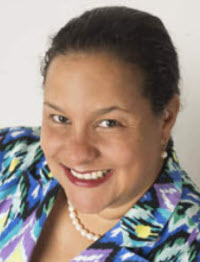Become a Patreon!
Abstract
Excerpted From: Warigia M. Bowman, Connections Between Black Wall Street and Oklahoma's All-black Towns, 57 Tulsa Law Review 293 (Winter 2021) (104 Footnotes) (Full Document)
 On June 1, 1921, Black residents ran down Greenwood Avenue, the heart of Black Wall Street, in fear for their lives. The 1921 Tulsa Race Massacre is one of the worst acts of racial violence in United States History. Black Tulsans rushed out of burning buildings, dodging torched houses, machine gun fire, and makeshift turpentine bombs dropped from civilian airplanes. As they fled, they left behind what had been a bustling commercial district.
On June 1, 1921, Black residents ran down Greenwood Avenue, the heart of Black Wall Street, in fear for their lives. The 1921 Tulsa Race Massacre is one of the worst acts of racial violence in United States History. Black Tulsans rushed out of burning buildings, dodging torched houses, machine gun fire, and makeshift turpentine bombs dropped from civilian airplanes. As they fled, they left behind what had been a bustling commercial district.
Many reports focus on the violence, arson, looting, and destruction of Greenwood. By contrast, this essay focuses on the impressive economic infrastructure that Freedmen in Tulsa built so painstakingly and racist Oklahomans so quickly destroyed. During the 1921 Tulsa Race Massacre, over thirty city blocks--housing over 1,000 residences and 600 successful businesses--were razed and burnt. In today's dollars, financial losses from the 1921 Tulsa Race Massacre totaled $26,752,705, but if one measures the loss of the ability to build wealth and pass it down to descendants, the 1921 Tulsa Race Massacre erased $610,743,750 in accumulated wealth At its height, Greenwood represented a vibrant community and a bustling, dense, and thriving commercial district with patrons of multiple ethnicities, races, and backgrounds. Tulsa was considered “The Negro Metropolis of the Southwest.” But for all its splendor, Tulsa was simply the largest of many thriving Black Oklahoma commercial communities; nationally, Black communities such as Richmond, Virginia; Birmingham, Alabama; and Durham, North Carolina similarly thrived. This essay explores the roots of Black commercial success in Oklahoma's All-Black towns.
Like African American voting rights, African American economic success has been undermined and attacked during slavery, during Jim Crow, during segregation, and even now, under seemingly neutral premises. Studying the rise and fall of Oklahoma's Black towns can help activists, scholars, and entrepreneurs design effective strategies to enhance and protect Black economic self-sufficiency. All-Black towns also provide insights into the resurgence of the “Buy Black” movement, the importance of access to capital for African Americans, and the pivotal nature of land in ensuring Black intergenerational wealth.
Despite the successes of icons such as Oprah Winfrey and Daymond John, Black entrepreneurs--in the aggregate--still face obstacles to success. African Americans are denied loans nearly twice as often as their white counterparts. Homeownership in the Black community lags behind that of white homeownership, in part due to the legacy of redlining. In addition, Black farmers receive a disproportionately low percentage of loans from the U.S. Department of Agriculture. This systemic denial of Black farmers from accessing timely lending and restructuring resulted in the landmark settlement of Pigford v. Glickman.
[. . .]
What do Black business districts need besides a reduction in racial violence and an increase in social justice? All-Black towns and Greenwood benefited from the availability of capital and suffered in its absence, pointing to the importance of providing Black-owned and minority-owned businesses access to capital and lines of credit. Importantly, Kristi Williams, Eli Grayson, and other survivors of the 1921 Tulsa Race Massacre were also descendants of Black Freedmen enslaved by Native Americans until the end of the Civil War. In the wake of the Civil War, U.S. Treaties required slave-owning tribes, including the Choctaws, Chickasaws, Cherokees, Muscogee Creek, and Seminoles--to share tribal land and other resources and rights with freed Black people who the tribes had enslaved. Other Black farmers gained their land during the Oklahoma Land Rush. According to Rev. Travis L. Doolin, Pastor of Flipper Chapel African Methodist Church in the historically Black town of Taft, Oklahoma, “[k]ey to their success was ownership of their own land, on which they were able to use a self-help concept grounded with a sense of community in which mutual aid was the theme.”
All-Black towns thrived when they created diversified economies and failed when they relied too heavily on monoculture. The emergence of All-Black towns suggests that Black communities need skilled workers. Black towns attempted to fill this gap by prioritizing education and literacy. Black towns were met with varying degrees of success when seeking help from Black and white philanthropists such as the Rosenwalds, Rockefellers, Carnegies, and, of course, Booker T. Washington.
The story of Greenwood is a story of resilience, not just sorrow. After racist vigilantes burned and razed Greenwood to the ground, residents rebuilt. Indeed, in 1925, Booker T. Washington's National Negro Business League held its annual meeting in Tulsa's partially restored business district. The story of Greenwood is a story not just of Black and white but also of Native American Freedmen, who were given an economic boost by their land ownership. The story of Greenwood encourages us to imagine the Tulsa that residents of all ethnicities could call home had Greenwood had not been destroyed.
Warigia M. Bowman earned her undergraduate degree from Columbia University in New York, her law degree with honors from the University of Texas at Austin, and her doctorate from the Kennedy School of Government at Harvard University. She is a Professor of Law at the University of Tulsa College of Law.
Become a Patreon!


